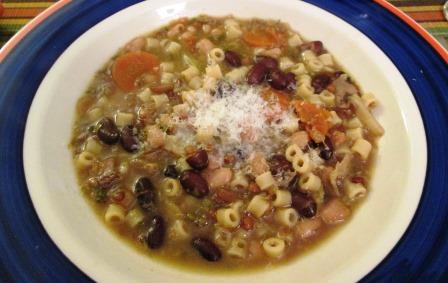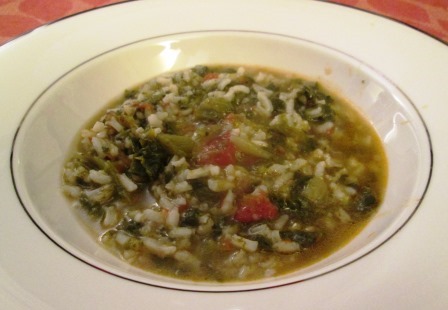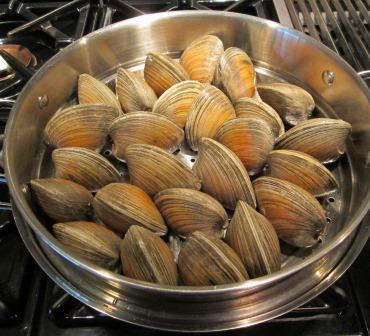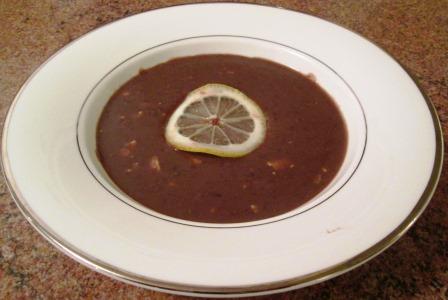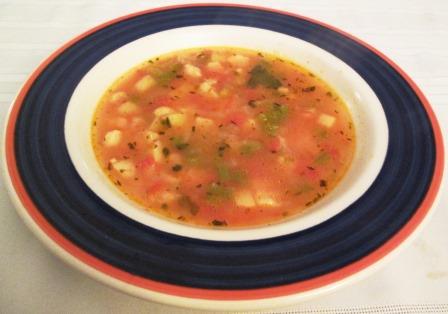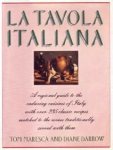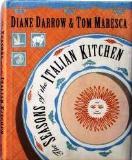The new recipe I tried this week was irritatingly ill-written. With certain substantial changes, I felt it made a decent dish, though Beloved Spouse didn’t agree. But it might have been a complete washout.
My making it was occasioned by having a few extra ears of fresh corn in the refrigerator. I’m very fond of corn soup as it’s usually done in Mexican cuisine – with rajas of poblano peppers, sour cream, and queso fresco – but this day I wanted a version that would use ingredients I already had on hand. That included not just the corn, but the near-last of the season’s tasty small heirloom tomatoes.
.

.
Searching on the Web, I was attracted to a recipe for Mexican Corn Soup, credited to the TV food network. Now, I don’t watch the food channel, so I’m not familiar with the quality of its recipes. On a casual reading, the recipe looked reasonable, so I copied it out and gave it a try.
Here’s the first problem I encountered. The ingredient list included 2 cups of chicken broth. The first paragraph of the instructions called for using 2 cups of broth. The third paragraph called for the “remaining” 2 cups of broth. 2 + 2 = 2? Well, I said to myself: just a typo. It must have meant 4 cups of broth.
The recipe also wanted me to scrape the kernels off raw ears of corn, using a small knife or spoon. I think doing it that way is absurd: It mashes the kernels into a squirty mess. My serrated bread knife cut them off easily and neatly. While the recipe expected a yield of 3 cups of kernels from 4 ears, my 3 large ears made 4 cups. No big problem there: I’d just up all the other quantities a little. (I did, but to keep this description simple I’ll write as if for the recipe’s quantities.)
.

.
Then I was to put half the kernels in a blender, with 2 roughly chopped tomatoes, the first 2 cups of broth, and some oregano (not specified as the Mexican type, which is very different from Italian; I assumed Mexican oregano would be preferable, and so used that) and puree it all until smooth. Two problems there: (1) No normal-sized household blender will hold that amount of fluid food without spewing it all over the kitchen. Even my big food processor had to do it in batches. (2) 2 cups of corn, 2 chopped tomatoes, and 2 cups of broth don’t make a puree; they make a liquid.
My faith in this recipe was rapidly waning.
The next step was to cook 4 slices of thick-cut bacon “in a large saucepan, turning once, until brown and crisp, about 10 minutes.” I dutifully used a saucepan, though a skillet would have done it much more handily, and turning the bacon only once in all that time is just silly. When the bacon strips were done, I set them to drain on paper towels and softened chopped onion and garlic in the remaining bacon fat in the saucepan. Nothing wrong with that step, at least, though it took a lot of stirring to get the bacon residue off the bottom of the pan. Dicing the bacon before crisping would have been smarter, easier, and better for the subsequent soup.
Moving right along, the next direction called for adding the alleged corn-tomato puree to the saucepan, along with the problematic second 2 cups of broth. That much additional liquid would have thinned out the soup drastically, so I used no more broth. Then I had to bring the soup to a boil, stir in the remaining corn kernels, and simmer, stirring occasionally, “until thickened, about 20 minutes.” I was also to “remove any foam as it develops with a large flat metal spoon.”
.

.
Foam did certainly develop, as can be seen above, but I didn’t skim it off because it was the kind that I knew would melt back into the soup during the cooking. It did. And the soup actually thickened in the specified time, which, given the recipe’s track record so far, surprised me.
Finally, I was to stir in salt, pepper, chopped parsley, and an optional ½ cup of heavy cream. I did add the pepper and parsley; held off on the salt because there’d be a garnish of salty cheese, as well as saltiness from the bacon; and skipped the cream. Since a taste had told me the soup was extremely sweet from the corn, more cream sweetness struck me as exactly the wrong sort of addition.
At serving time, an optional garnish was queso fresco, to be crumbled into the soup bowls along with the bacon. The Mexican cheese I had on hand was cotija, a stronger, dryer, saltier cheese, somewhat resembling ricotta salata, and like it an ideal texture for crumbling. I thought it would be an important counterpoint to the corn’s sweetness, and so it was.
.

.
It was a strange-tasting soup. Didn’t seem very Mexican. There was a hint of something like cumin in the flavor, and I couldn’t think what was causing it. My broth was a homemade mélange of poultry, meat, bones, and vegetable trimmings, not pure chicken broth – but it had never made enough difference in other recipes to account for the oddity here. Beloved Spouse doused his portion with Cholula hot sauce to cut the extreme corn sweetness; I just heaped more crumbled cotija on mine.
I can say I mildly liked the dish, but I’m sure I’d have hated it if I’d blindly followed the recipe.
As for that fundamental 2 + 2 = 2 problem, I think the error was to put any broth in the blender at all. The only 2 cups should go into the saucepan at the end. Not that I think that would have altered the final flavor of the soup: Sweetness that intense comes from modern super-sweet corn, and there is nothing we can do about it.
Read Full Post »







